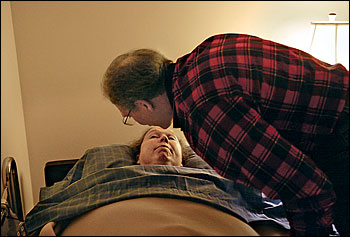
Speaking of marriage vows, Liza Mundy highlighted an incredible commitment of love in her Washington Post magazine piece about a devoted husband, Dave Kendell, who cares for a disabled wife, Diana, and all that entails: preparing her meals, fixing her hair, keeping her active.
The incisive article discusses the toll of aging and infirmity on the baby boom generation.
I’ve excerpted the beginning, but you can get to the entire article by clicking here.
SHE MIGHT HAVE SEEN A SHIMMER ON THE WATER, OR SOMETHING ELSE COULD HAVE TRIGGERED HER REACTION. All Dave Kendall knew was that one minute he was sitting in the stern of his fishing boat, steering, during an excursion on the Occoquan Reservoir about a decade ago. The next minute Diana, his wife of more than 20 years, had fallen from her seat near the bow. She was on the floor of the boat, limbs flailing in what looked like a violent seizure.
Diana had had fainting spells before, but doctors had not determined the cause. They didn’t this time, either. Yet there were other things that now seemed wrong with Diana: She was having bizarre reactions to music, which made her head hurt so acutely that she would sometimes bolt out of church. One day, she came home from work at Fort Belvoir saying she no longer remembered how to use Excel. Dave, giving her a refresher session, saw that she was losing her focus.
And she was gaining weight. Diana, who had always been trim and active, began eating junk food and sitting for days, crying. Dave took her to more doctors, including a neurologist who said he wanted to run a test for something called Huntington’s disease. He didn’t tell them much about it — just that they had better hope the test came back negative.
Dave felt reasonably optimistic while they were waiting for the results. Doing some Internet research, he learned that Huntington’s is a hereditary disorder, and they didn’t know of anyone in Diana’s family who had it. The life the Kendalls had built together — decades of hard work that had allowed them to leave behind impoverished childhoods in rural Virginia for the middle-class comforts of suburban Washington — felt secure.
But when they returned to the neurologist on August 6, 2000, they learned that the future wasn’t secure at all. The test had come back positive. “This is really bad news, isn’t it?” asked Diana, turning to Dave. She was strikingly calm and dry-eyed. It was the beginning of a transformation in her; deterioration, yes, but also acceptance and what can only be described as grace. It was also the moment — Dave realizes in retrospect — when she entrusted herself to his care. It was the end of married life as they had known it, the beginning of marriage in an entirely new form. Same contract, radically altered circumstances. “She put her life in my hands,” he says.
Diana was 48; Dave was 51. By then, they had been living with a fatal neurodegenerative disease for several years. Parts of Diana’s brain were dying, an inexorable process caused by a single abnormal gene, a glitch that affects everything: thought, mood, movement. After the diagnosis, Dave began keeping a journal to record Diana’s rapid decline.
“She was unable to walk in grocery store to complete shopping — sat on bench,” he wrote in December 2001, adding, “I start peeling apples, potatoes, etc., to avoid accidents with knives.”
In February 2002: “Walks like a drunk — falls against wall.”
In August 2002: “Cannot find hymn number in book. Leans while sitting.”
In October 2003: “Cannot put her shoes on” and “could not get out of chair.”
In April 2005: “Could not subtract 6 from 1977.”
In November 2005: “This is the first Thanksgiving in which I had to spoon feed her.”
In May 2007: “Di has no ability to read anything or create a thought. I do it and ask her if she likes the thought.”
More than seven years after Dave began keeping his journal, Diana has lost her balance and her ability to stand unaided. She can count forward from one to 10, but not backward from 10 to one. She is immune to boredom and has no sense of the passage of time. Yet she is still capable of teasing Dave, as well as expressing a deep appreciation of what her disease has cost her husband. Three years ago, he asked her what her New Year’s resolutions were. “To read my Bible more,” she said, “and to be less of a burden to you.”
Dave, now 59, recalls this on a clear day in mid-winter. He is sitting at a table in the airy, immaculate kitchen he built for Diana. The kitchen was supposed to be something they would enjoy together. But by the time the cooktop and cabinets were installed, Diana’s illness was too far along for her to really use it. “I would have liked just to clean it,” she will sometimes say, wistfully, her speech choppy and hard-won, her words articulated with labor.
Diana is at the table with Dave, sitting in an electric-blue wheelchair, drinking water through a straw — swallowing is so difficult that she makes clicking sounds as she drinks — and watching through the Palladian window as a pileated woodpecker pecks its way around a maple tree in spirals.
On a computer bulletin board recently, Dave heard of a woman who lived 30 years with Huntington’s. By the end, she weighed 44 pounds. It is an illness that can have a very long trajectory: 10 to 20 years is the estimated life-span after diagnosis, but there is no way to know. The better care Dave takes of Diana — and he takes very good care of her — the longer she will live. The longer she lives, the longer he has to live like this: Waking in the night to take Diana to the toilet or settle her after an anxiety episode. Getting up early to prepare her medications and make her breakfast, then rushing home from work to fix them both dinner. Feeding Diana, cleaning Diana, hoisting Diana up and down the stairs. Never taking vacations. Going to weddings and other events by himself. Sleeping alone. And sleeping little.
He is taking the ultimate test of marital commitment in the modern medical era.

